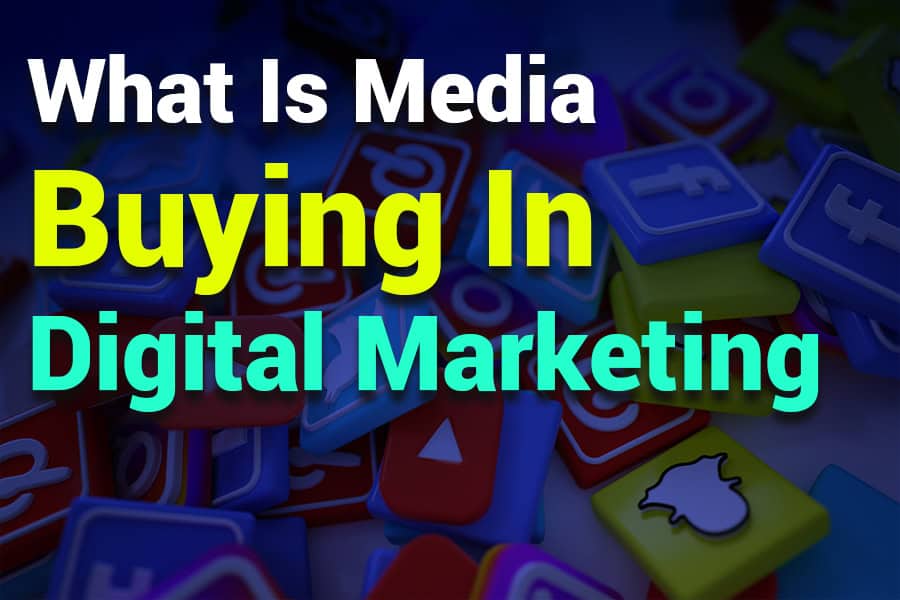What is Media Buying in Digital Marketing: A Comprehensive Guide

In digital marketing, media buying has become a cornerstone for brands aiming to increase visibility and drive targeted engagement. But what exactly does media buying entail, and how does it impact a brand’s digital marketing efforts? Media buying refers to purchasing ad placements across digital platforms, like websites, social media, and search engines, to ensure a brand’s ads appear in front of the right audience. Effective media buying maximizes the chances of ads being seen by potential customers, thereby increasing the return on investment (ROI).
Digital media buying can be complex, involving planning, negotiations, and precise targeting, especially as the online landscape becomes more competitive. The process includes securing the best ad placements, managing budgets efficiently, and utilizing analytics to optimize campaigns. This guide dives deep into what media buying is, explores different strategies, discusses the role of metrics and tools, and addresses digital marketers’ challenges. Whether new to digital marketing or looking to refine your approach, this article provides the knowledge you need to succeed in media buying.
What is media buying in digital marketing?
Media buying in digital marketing is purchasing ad placements on digital platforms to promote a brand’s message to targeted audiences. It involves choosing the best ad spaces, negotiating costs, and analyzing audience data to optimize ad performance. Media buying is crucial for increasing a brand’s visibility and engagement by reaching potential customers on the platforms they frequent. By focusing on strategic ad placement, marketers ensure the brand message reaches the right audience at the right time, ultimately improving the campaign’s ROI.
Media Buying in Digital Marketing
Media buying is the process of purchasing ad placements to promote a brand’s message across various digital platforms. The primary goal is to ensure that ads appear before the target audience, generating brand awareness and driving engagement. This section explains media buying in digital marketing, breaking down its elements, benefits, and how it’s used in today’s digital landscape.
Content:
- The Role of Media Buying
Media buying ensures that the ads appear where and when the target audience is most likely to see them. It involves purchasing ad space across different channels like social media, search engines, and websites to engage specific demographics. Marketers achieve greater ROI by optimizing these ad placements. - How Media Buying Differs from Media Planning
Media buying focuses on executing and purchasing the ad placements, while media planning is about strategizing which channels to use and setting the budget. Both work together to ensure a successful advertising campaign. - The Objectives of Media Buying in Digital Marketing
Media buying seeks to maximize ad exposure, optimize budget use, and increase the likelihood of conversion. This is done by carefully selecting ad formats, platforms, and times for the best impact. - Components in Media Buying
Media buying includes target audience analysis, channel selection, budget allocation, and performance monitoring. Each component is essential for effectively achieving the campaign’s objectives. - The Evolution of Media Buying
Media buying has evolved from manual ad placements to programmatic media buying, where automation and data analytics play a major role. This transition has allowed marketers to make more data-driven decisions and optimize ad placements for better engagement and results.
How Does Media Buying Work?
Media buying consists of a step-by-step process that ensures an ad reaches the intended audience through appropriate digital channels. By breaking down this process, marketers can understand each stage and implement media buying strategies that maximize their campaign effectiveness.
Stages of Media Buying:
- Research and Audience Analysis
- Understanding your audience is the first step in media buying. Research helps identify the audience’s demographics, behaviors, and preferences, allowing brands to select channels that resonate with their audience.
- Budget Allocation
- Allocating a budget is essential. Marketers decide how much to spend on each channel and ad format depending on the campaign’s goals and anticipated ROI.
- Platform Selection and Negotiation
- Choosing platforms where the target audience is active is critical. Negotiating prices for ad placements helps secure high-quality spaces while staying within budget. Factors like ad type, platform popularity, and audience preferences affect this decision.
- Campaign Setup and Ad Placement
- Setting up a campaign includes designing the ad creatives, selecting ad formats, and scheduling the timing for placements. Ad placements are set up to appear at optimal times to ensure maximum engagement.
- Optimization and Analysis
- After launching, campaigns need continuous optimization. By analyzing metrics like click-through rate (CTR) and conversion rate, marketers can refine their strategies for better performance. This stage involves adjusting elements like targeting, ad creatives, and timing to boost engagement and ROI.
Benefits of Media Buying in Digital Marketing
Media buying offers multiple benefits, including:
- Increased Audience Reach
Media buying allows brands to reach larger, more specific audiences through targeted placements on popular platforms. - Enhanced Brand Visibility
Brands enjoy increased visibility as ads appear on high-traffic sites and social media platforms, making it easier for audiences to notice the brand. - Cost-Effectiveness
With media buying, budgets are allocated smartly, focusing on platforms with higher engagement rates for cost-efficient marketing. - Higher Engagement Rates
By choosing platforms and ad types tailored to the target audience, media buying boosts engagement rates, leading to more interactions and potential conversions. - Data-Driven Decisions
Media buying utilizes analytics to make data-driven decisions, allowing marketers to refine campaigns based on real-time insights, optimizing ad spend, and enhancing campaign effectiveness.
Types of Media Buying Strategies
Several types of media buying strategies are available in digital marketing, each designed to cater to specific campaign goals. Here’s a detailed look at these strategies:
Types:
Direct Buying: Direct buying involves negotiating ad placements directly with publishers. This strategy works well for premium placements, offering brands a competitive advantage.
Real-Time Bidding (RTB): In RTB, ads are bought and sold in real-time auctions, allowing for flexible pricing and quick responses. This strategy is commonly used for display ads, where competition is high.
Programmatic Buying: Programmatic media buying automates ad buying using AI and machine learning. Leveraging audience data it enhances targeting accuracy, often leading to better performance.
Social Media Buying: Social media buying focuses on platforms like Facebook, Instagram, and LinkedIn. With built-in targeting tools, marketers can reach specific demographics effectively.
Search Engine Advertising: Paid search ads on platforms like Google Ads allow brands to capture high-intent traffic. Search engine advertising is often used for pay-per-click (PPC) models, where brands pay only for clicks, optimizing budget use.
Metrics and Tools for Measuring Media Buying Success
Metrics are essential to evaluate the success of media buying campaigns. This section covers the metrics that matter most and the tools that assist marketers in tracking and optimizing campaigns.
Important Metrics:
- Impressions – Measures how often an ad is shown, giving insight into ad reach.
- Click-Through Rate (CTR) – Indicates the percentage of clicks relative to impressions, showing ad engagement.
- Conversion Rate – Reflects the percentage of users who took action, such as making a purchase or signing up.
- Return on Ad Spend (ROAS) – Assesses the revenue generated per dollar spent, crucial for understanding the campaign’s profitability.
- Cost per Thousand Impressions (CPM) – Calculates the cost for every 1,000 impressions, providing insight into ad efficiency.
Recommended Tools:
- Google Analytics – Offers detailed user behavior and engagement tracking.
- Facebook Ads Manager – Useful for managing and tracking social media ad campaigns.
- SEMrush – Provides competitive insights into advertising strategies.
- Adobe Analytics – A robust tool for tracking multi-channel ad performance, allowing for detailed analysis.
Common Challenges in Media Buying and How to Overcome Them
Despite its advantages, media buying presents certain challenges. Understanding these issues and how to address them is essential for any marketer.
Challenges and Solutions:
High Competition
With more brands investing in digital ads, competition for ad space has intensified. Focusing on niche markets can help reduce competition and improve ad relevance.
Ad Fatigue
Audiences may get tired of seeing the same ad repeatedly. Rotating creatives and adjusting targeting can help maintain engagement levels.
Budget Constraints
Limited budgets can restrict ad reach and frequency. Allocating budget effectively and prioritizing high-performing channels helps maximize impact.
Tracking and Attribution Issues
Accurately tracking ad performance across platforms can be challenging. Using integrated analytics tools and setting clear KPIs can enhance tracking.
Final Thoughts
Media buying in digital marketing is a powerful tool, enabling brands to reach their audiences effectively. By understanding the steps involved, the types of strategies, and the importance of data-driven optimization, brands can maximize their campaign’s success. Media buying requires adaptability and a focus on innovation as digital trends evolve. Brands that stay updated and continuously refine their strategies greatly benefit from media buying’s potential to enhance reach, engagement, and conversions.
FAQ’s
Q. Why is media buying important?
A. Media buying maximizes ad reach, helps target specific audiences, and increases brand visibility, improving ROI on marketing efforts.
Q. What types of media buying are there?
A. Types include direct buying, real-time bidding, programmatic buying, social media advertising, and search engine advertising.
Q. How is media buying measured?
A. Metrics like impressions, CTR, conversion rate, ROAS, and CPM help gauge media buying effectiveness and guide optimization.
